Food
Gyros
Gyros is one of the most popular Greek street food dishes, consisting of meat such as pork and chicken (in Greece) or lamb and veal (popular in other countries) cooked on a vertical spit. The meat is sliced in thin shavings and is then usually placed in a pita bread along with sauces such as tzatziki and vegetables such as tomatoes, onions, lettuce, and cucumbers.
Gyros is derived from the Greek word gheereezo, meaning to turn, referring to the constantly rotating vertical spit on which the meat is cooked. Some believe that gyros originated during the time of Alexander the Great, when his soldiers skewered the meat on their swords and cooked it over a fire.
Others claim that gyros was introduced to Greece in 1922, with the refugees from Constantinople and Smyrna. Many of the refugees became merchants and opened their shops with tiny holes in the wall, where gyros was sold. After WWII, gyros gained popularity and spread to Europe, Australia, and the United States.
Today, gyros is known as one of the most popular street food varieties around the world.
Fish & Chips
Classic fish and chips are a British institution and a national dish that everyone can’t help but love. You can buy them from one of the thousands of fish and chip shops all over the country, including the world-famous Harry Ramsden’s—or you can make them at home.
Use a thick white fish for this recipe; sustainable cod, haddock, or pollock are preferable. The fillets are dipped in a flour batter that includes both dark beer and sparkling water, and the carbonation ensures a light, crispy fried fish. The “chips” are simply freshly cut fried potatoes. Use one pot to fry the chips, then the fish, then the chips again (for that crisp exterior and fluffy interior) to ensure both fish and chips are ready to eat at the same time. Serve with a pint and bring the pub home.
Cheese Fondue
The Best Cheese Fondue Dippers will give you some ideas on some fun things to dip in your favorite cheesy recipe. Once you start making fondue meals, it can get quite addicting.
If you’re looking for more fondue ideas, Best Cheese Fondue Recipe and Creamy Chocolate Fondue will get you started on creating the perfect meal for friends and family.
If you don’t have a favorite cheese fondue recipe, don’t worry – I’ve got you covered. Click on the link below for my recipe on how to make cheese fondue.
Now that you found that perfect cheese fondue recipe – the next question is “What to dip in cheese fondue?”
We all know cheese makes everything taste better, so there’s many ideas to pick from.
What is Cheese Fondue?
It is a yummy combination of cheeses, wine, and seasonings heated until they turn into a melted cheesy dip.
History of Cheese Fondue
It is thought that cheese fondue originated in 18th century Switzerland. Because winter was so harsh and food was so hard to come by, farmers used what little they had to create a meal.
They used leftover cheese, stale bread, and a little wine – the family gathered around the fireplace for a delicious meal. If that isn’t a cozy lifestyle – I don’t know what is!
How to Host a Cheese Fondue Party
1) National Cheese Fondue Day is April 11th. Why not throw an annual party to celebrate with your favorite cheese fondue dippers?
2) Make sure you have a large enough pot for the number of guests you have. You can also have multiple pots for different types of fondue.
3) Serve cheese fondue and chocolate fondue to tantalize your guest’s taste buds.
4) To save money and time, make your fondue party a potluck party. Give everyone a couple of things they can bring to ease the burden on you.
5) Make sure you have enough fondue forks for everyone and a few extra if someone drops one.
6) Have a variety of cheese fondue dippers in an array of colors.
7) Cut up everything before everyone arrives to make things easier on everyone.
8) Place food on platters for easy access and have a few small tongs handy on the platters.
9) You can create a retro environment with music and decor.
Creating a Cozy Life Group
Since you clicked on a post about ideas for cheese fondue dippers, I’m guessing you like all things cozy living. I created a Facebook group called Creating a Cozy Life with over 55,000 like-minded souls.
It’s a group where we share recipes, pictures of things that leave you in awe, and ideas on how to make your life just a little bit more snug.
Tips on Your Cheese Fondue Dippers
1) You should cut everything up into bite-sized pieces ahead of time. This simplifies your dining experience because you’re able to dip the item and pop it in your mouth.
2) Keep in mind that whatever you pick to dip in cheese fondue, it should hold up after it becomes moist. If something becomes flimsy after dipping it will create a big mess that no one wants.
3) If you decide to use pickles, make sure you rinse them off and pat them dry before using. You don’t want the salty brine to change the taste of your melted fondue.
4) You can coat your meats in different flavors to test the best cheese and meat combinations. Teriyaki, garlic-pepper, and herb-crusted are just some of the ideas to use.
5) Make sure your beef rests before using in the fondue pot. If you don’t let it rest beforehand, medium rare and rare beef can bleed into the melted cheese.
Tips for using your fondue pot
1) You want to use fondue forks for your dinner. Using these specially designed forks helps prevent burns and from fingers touching the cheese.
2) Make sure you keep the cheese fondue warm, otherwise the cheese will solidify quickly.
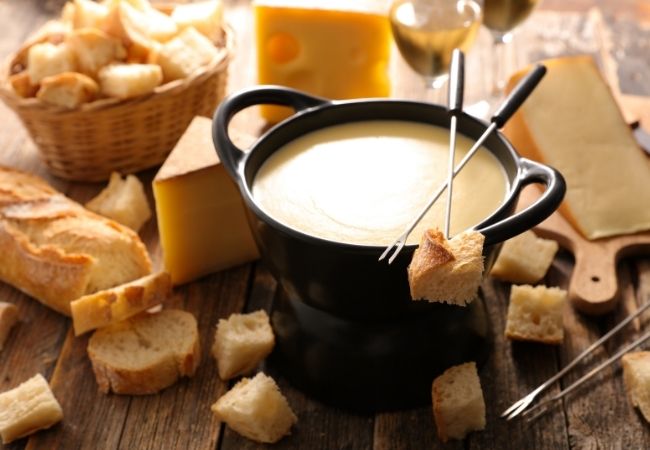
Cubed pieces of bread
Bread and cheese go together wonderfully. Bread is one of the most popular things to dip in cheese fondue.
What is the best bread for cheese fondue? That depends on your taste.
You’ll want to toast your bread to prevent it from falling apart once you dip it in the cheese fondue.
Sourdough bread, French bread, rye bread, pumpernickel bread, Brioche, whole wheat bread, olive bread, Focaccia bread, Ciabatta bread, Naan, and Challah are just some of the cheese fondue dippers to pick from.
Other bread-type ideas for dipping in cheese fondue are breadsticks, bagels, English muffins, and tortillas. Sweet bread with nuts and dried fruits can also pair well with cheese fondue.

Pretzels
For a special night, making your own homemade pretzel recipe might be worth the time and effort. Homemade pretzels are easier than you think.
You could also use store-bought pretzels as cheese fondue dippers. If you decide this is the option for you, make sure you get the thicker, long wands for easy dipping because you won’t be able to put them on your fondue fork.
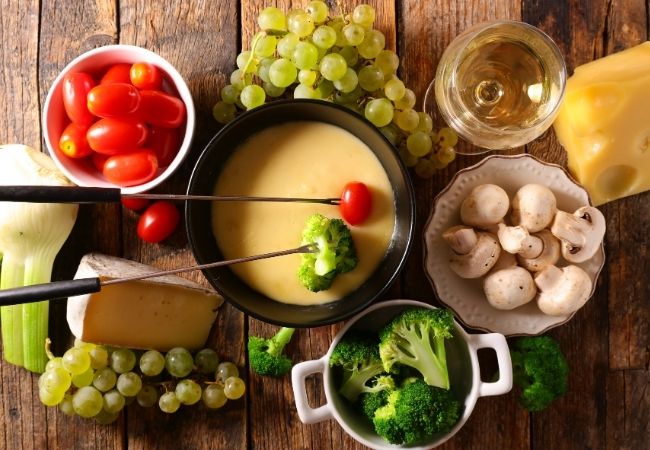
Vegetables
What veggies do you dip in cheese fondue?
Asparagus, zucchini, artichoke hearts, mini sweet peppers, carrots, Brussels sprouts, cauliflower, tomatoes, broccoli, mushrooms, green beans, baby potatoes, fingerling potatoes, French fries, tater tots, pearl onions, red onion, sweet onions, and squash all taste amazing dipped in cheese fondue.
You can have your vegetables roasted, pickled, steamed, or raw – depending on your taste. Roasted vegetables are one of my favorite cheese fondue dippers.
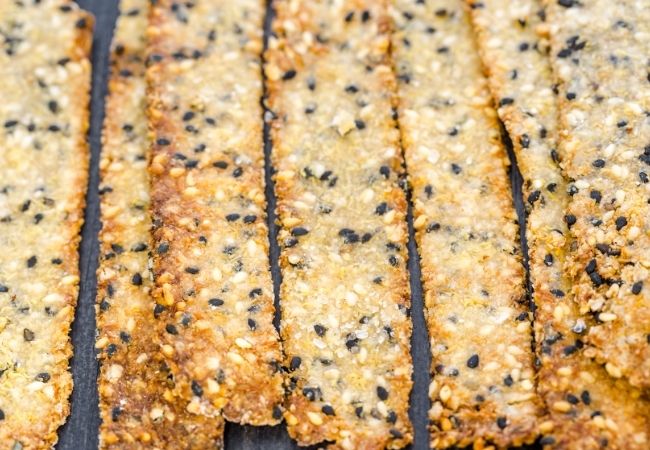
Crackers or chips
Wheat crackers, pita chips, potato chips, and tortilla chips all taste great dipped in cheesy fondue recipes.
You can even make your own homemade crackers and shape them into long narrow form.
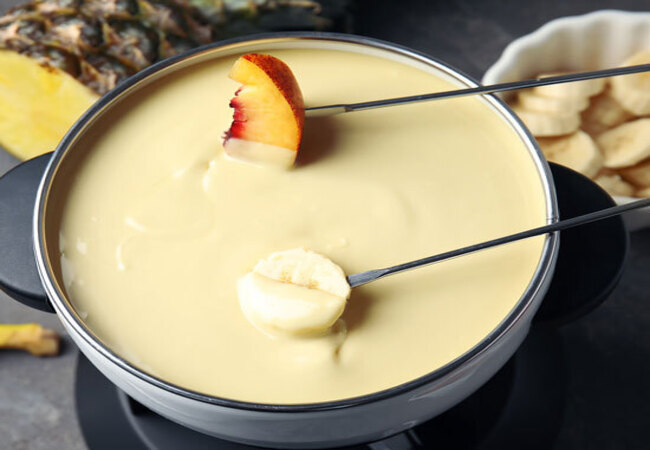
Fruit
Pairing fruit with cheese fondue wouldn’t be the first thing you think of when coming up with ideas, but some fruit choices are very tasty.
Sliced apples, pears, and grapes all work well with cheese fondue. I personally love tart green apples to dip in my cheese fondue recipe.
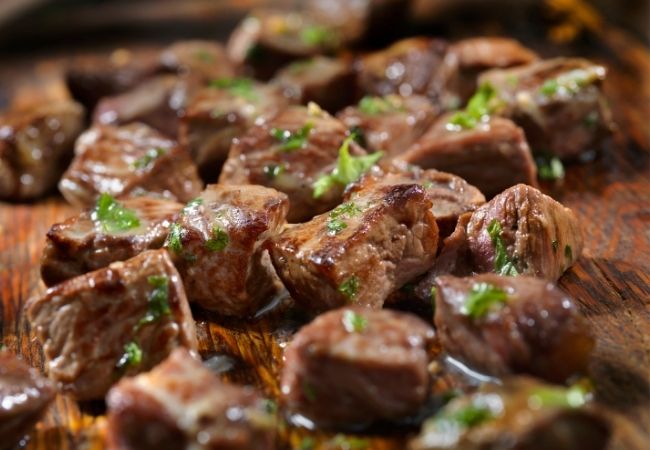
Bite-sized pieces of meat
Meat should be fully cooked before you use to dip into your cheese fondue.
Marinated sirloin, filet mignon, herb-roasted chicken bread, prime rib, mini-meatballs, beef jerky, miniature smoked sausages, duck breast, and chunks are ham will satisfy any meat lover.
You can also use cured meats as dippers for your cheese fondue like salami, chorizo, pepperoni, and soppressata.
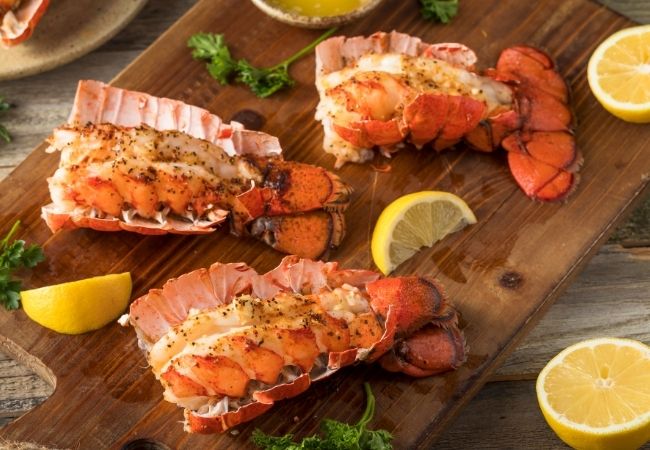
Sea Food
Cooked shrimp, salmon, lobster tail, crab legs, and Ahi Tuna will make a nice compliment to your meat choices for a touch of cheese fondue dippers indulgence.
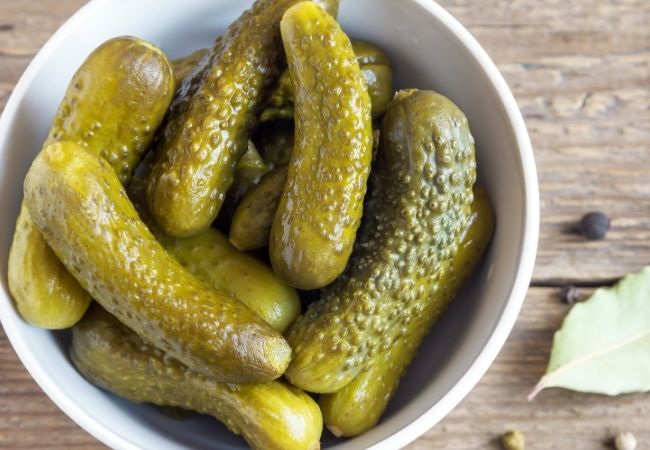
Others
Potstickers, pickles, pasta (especially ravioli), and roasted jalapeño peppers are other fun ideas to use in your fondue pot.
I hope these ideas will help you create a beautiful meal for your friends and family. Fondue gatherings are one of the best cozy dining ideas we can create at home.
Herring
Pickled, raw, broiled, grilled, steamed, and fried are just some of the ways to cook herring, a small, oily fish that’s found worldwide. It’s neither a strong-tasting fish like salmon, nor a mild one such as cod, and it’s much smaller than both. Herring is strongly associated with Eastern European, English, Scandinavian, and German cuisine, though some parts of Asia and the Caribbean have also taken to the food. Herring is a versatile fish beloved for its small size, firm and silky flesh, and ability to be prepared in a variety of ways.
What Is Herring?
Herring doesn’t grow longer than 16 inches or so, and it is found worldwide in both fresh and salt water. This means herring is common in cuisines all over the world.
How To Make Smashed Pickles?
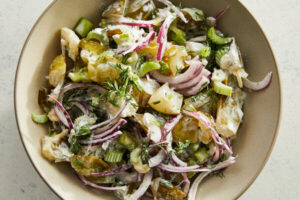 Herring moves in schools, with a single school hosting around three billion. It has a fairly long life span, lasting up to 15 years in the wild. Those that are caught young and small are often mistaken for sardines, and in some cases are marketed as such.
Herring moves in schools, with a single school hosting around three billion. It has a fairly long life span, lasting up to 15 years in the wild. Those that are caught young and small are often mistaken for sardines, and in some cases are marketed as such.
In the kitchen, herring often gets preserved, often either smoked or pickled. These iterations generally are found in countries such as Russia, Poland, Scandinavia, Great Britain, and the Netherlands. Pickled herring has a lot of holiday ties and remains one of the most common things served on Christmas Eve in Poland, Lithuania, and Ukraine. In Germany, Poland, the Czech Republic, and Scandinavia, herring is a lucky food served on New Year’s Eve, symbolizing prosperity.
Smoked herring is common in the Caribbean, Ireland, England, and parts of North America. Most of the time smoked herring falls under the moniker of kippers, and is cold smoked long enough to tint the flesh red.
How to Cook Herring
There are many ways to cook and prepare herring, such as from boiling, frying, smoking, roasting, grilling, and pickling. Smoked or pickled herring makes a nice accoutrement to an appetizer spread, and is often served at breakfast in Scandinavian countries. Most fresh herring has to be cooked right away as it gets pungent fast, and although it can be filleted fresh for the grill, pan-fried, or deep-fried, most herring is cured for consumption. Pickled herring is the most common way to eat herring, which requires a vinegar, salt and sugar mixture that often includes onion, bay leaves, and peppercorns.
Other ways to prepare herring include baking the fish whole (with or without heads) after stuffing it with herbs and spices. Coating it in breadcrumbs and deep frying can be delicious, though you can’t necessarily get the nuances of the fish this way. There’s also grilling; typically the fish is filleted and marinaded or at the very least treated with salt, pepper, and oil.
What Does Herring Taste Like?
When eaten fresh, herring has a distinct flavor similar to a sardine. It’s an oily fish so it flakes off in moist chunks, and the rich fatty components give herring a hearty body that’s fulfilling and coats the palate. Pickled herring tastes quite different and tends to have a vinegary bite that works well with cream cheese, sour cream, onions, and grainy breads.
Herring vs. Sardines
Herring and sardines often get confused with each other, though despite the similarities there are some differences. First of all, while both fish are in the Clupeidae family, not all herring are in this family. Furthermore, sardines are in the genera Dussumieria, Escualosa, Sardina, Sardinops, and Sardinella, and herring are the genus Clupea. Because herring and sardines have a lot in common, some fisheries classify them the same way, calling them both as sardines. That means if a can of sardines gets cracked open at happy hour, it could be young herring instead. Both are oily fish that swim in schools and have the same silvery fins with a touch of blue and black to them.
Herring Recipes
Herring can be broiled, sauteed, fried, baked, and even pickled. The popular appetizer rollmops is a German food featuring pickled herring rolled around a gherkin or pickled onion. Pickled herring salad also proves prevalent in Russian cuisine, most notably Herring Under a Fur Coat, a layered dish featuring the fish along with grated boiled vegetables, onion, mayonnaise, hard-boiled eggs, and shaved beets. Try it out in one of these traditional dishes and then experiment with herring in other ways.
Where to Buy Herring
Canned and pickled herring get sold at many Eastern European specialty stores, both physical ones and online. It’s a popular dish in Jewish cuisine, and visiting a Jewish deli or grocery is a good way to find it.
Some fishmongers may sell herring fresh, but it’s not common unless you happen to live in a country in which it’s consumed heavily. Smoked herring is more readily available canned and under the name kippers.
Storing Herring
Like most fresh fish, herring should be eaten within a couple days of consuming. Otherwise, freeze it for up to six months in an airtight container.
Once opened, pickled herring can last in the refrigerator for around three months. Canned smoked herring can be kept in packaging on the shelf until the expiration date, but once opened it’s best to refrigerate until ready to finish. Since it comes packed in oil, it can last for months stored this way.
Paella
Paella (/paɪˈɛlə/, /pɑːˈeɪjə/,py-EL-ə, pah-AY-yə, Valencian: [paˈeʎa], Spanish: [paˈeʎa]) is a rice dish originally from Valencia. While it is commonly viewed by non-Spaniards as Spain’s national dish, Spaniards almost unanimously consider it to be a dish from the Valencian region. Valencians, in turn, regard paella as one of their identifying symbols. It is one of the best-known dishes in Spanish cuisine.
The dish takes its name from the wide, shallow traditional pan used to cook the dish on an open fire, paella being the word for a frying pan in Valencia’s regional language. As a dish, it may have ancient roots, but in its modern form it is traced back to the mid-19th century, in the rural area around the Albufera lagoon adjacent to the city of Valencia, on the Mediterranean coast of Spain.
Paella valenciana is the traditional paella of the Valencia region, believed to be the original recipe, and consists of round-grain rice, bajoqueta and tavella (varieties of green beans), rabbit, chicken, sometimes duck, and garrofó (a variety of lima or butter bean), cooked in olive oil and chicken broth.
The dish is sometimes seasoned with whole rosemary branches. Traditionally, the yellow color comes from saffron, but turmeric and calendula can be used as substitutes. Artichoke hearts and stems may be used as seasonal ingredients. Most paella cooks use bomba rice, but Valencians tend to use a cultivar known as senia.
Paella de marisco (seafood paella) replaces meat with seafood and omits beans and green vegetables, while paella mixta (mixed paella) combines meat from livestock, seafood, vegetables, and sometimes beans, with the traditional rice.
Other popular local variations of paella are cooked all through the Mediterranean area, the rest of Spain and internationally.
Goulash
Hungarian Goulash is a delicious beef stew (or soup) with a rich paprika seasoned broth. This delicious dish is warm and comforting, perfect for a cold weather day.
Serve this over homemade noodles (or add potatoes) or with a side of bread or Biscuits to sop up any of the broth left in your bowl.
Now that it’s autumn, the only real way to stay warm is this delicious Hungarian Goulash (gulyás). Homemade goulash is a staple in our family, and could not be more comforting as the sun turns to snow!
In this easy Hungarian Goulash recipe, tender chunks of beef, onions and tomatoes are simmered to tender perfection in a savory beef broth. YUM! While I most often simmer this on the stove, you can also make this easy Hungarian Goulash in the oven. A house filled with the aromas of this stew is probably the most comforting way to say goodbye to my patio until next summer!
Well for starters, it is one of the most delicious comfort food that exists (it’s up there with my oldest daughter’s favorite appetizer, jalapeno popper dip). A traditional Hungarian Goulash is a soup or stew that is usually filled with tender beef and onions spiced with paprika.
Many versions add other vegetables such as potatoes, carrots, onions, celery, peppers, and tomatoes.
It dates back centuries and was originally made by shepherds drying out meat to be able to store and then adding water to create a soup or stew. Everyone seems to have their own way of making this dish and adds different veggies. Regardless, Hungarian Goulash is very different from an American Goulash Recipe which is more of a tomato, beef and macaroni dish (and also sometimes known as American Chop Suey).
 Goulash is seasoned with paprika and other fragrant spices like caraway seeds and sometimes even cajun! You will almost always find red meat in a Hungarian goulash, and because it is simmered at a lower temperature for a longer amount of time, it is the perfect way to use a cheaper cut of meat and save some money!
Goulash is seasoned with paprika and other fragrant spices like caraway seeds and sometimes even cajun! You will almost always find red meat in a Hungarian goulash, and because it is simmered at a lower temperature for a longer amount of time, it is the perfect way to use a cheaper cut of meat and save some money!
To make the perfect Hungarian goulash you’ll want to start with onions and beef as the base and plenty of Hungarian Paprika! Fry the onions in butter until they are translucent.
Add the beef to the pan and sear it on all sides. Next, deglaze the pan by slowly adding the beef broth to it. Once deglazed, add the tomatoes and broth and season to taste.
Bring the Hungarian goulash to a boil, then reduce the heat, cover it, and simmer it for about an hour and a half (this is where it starts to smell like heaven throughout your house). Serve the goulash on its own or over spaetzle or spooned over Mashed Potatoes! We always serve it with bread or 30 Minute Dinner Rolls to sop up any leftover gravy.
Paprika is made from grinding up dried peppers. Peppers can range from hot to mild, so paprika will vary from region to region. In a lot of American cooking like deviled eggs, paprika is mainly used as a garnish.
In Hungarian cooking, paprika is usually used to flavor the dish instead of a garnish. Some paprika is smoked, some may be sweet, some may be mild, and some may have a stronger flavor. In Hungarian cooking, usually a mild to sweet paprika is used.
Pizza
Pizza (Italian: [ˈpittsa], Neapolitan: [ˈpittsə]) is a dish of Italian origin consisting of a usually round, flat base of leavened wheat-based dough topped with tomatoes, cheese, and often various other ingredients (such as various types of sausage, anchovies, mushrooms, onions, olives, vegetables, meat, ham, etc.), which is then baked at a high temperature, traditionally in a wood-fired oven. A small pizza is sometimes called a pizzetta. A person who makes pizza is known as a pizzaiolo.
In Italy, pizza served in a restaurant is presented unsliced, and is eaten with the use of a knife and fork. In casual settings, however, it is cut into wedges to be eaten while held in the hand.
The term pizza was first recorded in the 10th century in a Latin manuscript from the Southern Italian town of Gaeta in Lazio, on the border with Campania. Modern pizza was invented in Naples, and the dish and its variants have since become popular in many countries.
It has become one of the most popular foods in the world and a common fast food item in Europe, North America and Australasia; available at pizzerias (restaurants specializing in pizza), restaurants offering Mediterranean cuisine, via pizza delivery, and as street food. Various food companies sell ready-baked pizzas, which may be frozen, in grocery stores, to be reheated in a home oven.
In 2017, the world pizza market was US$128 billion, and in the US it was $44 billion spread over 76,000 pizzerias. Overall, 13% of the U.S. population aged 2 years and over consumed pizza on any given day.
The Associazione Verace Pizza Napoletana (lit. True Neapolitan Pizza Association) is a non-profit organization founded in 1984 with headquarters in Naples that aims to promote traditional Neapolitan pizza. In 2009, upon Italy’s request, Neapolitan pizza was registered with the European Union as a Traditional Speciality Guaranteed dish, and in 2017 the art of its making was included on UNESCO‘s list of intangible cultural heritage.
Raffaele Esposito is often considered to be the father of modern pizza
- ←
-
Email Us
Please send us an Email
